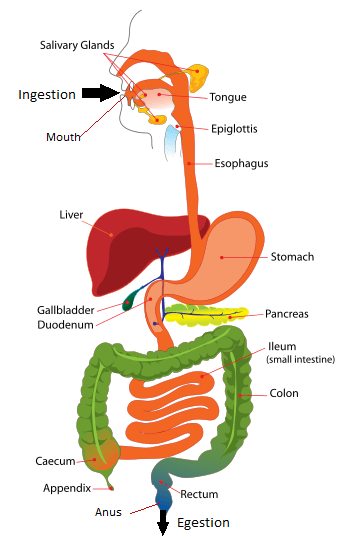Difference Between Ingestion and Egestion
Table of Contents
Key Difference – Ingestion vs Egestion
Ingestion and egestion are two essential processes that take place in all organisms though there exists a difference between them based on their functions. In multicellular animals, these processes occur in the gastrointestinal tract whereas in unicellular organism they occur through cellular membranes. Food undergoes a series of processes while it is in the gastrointestinal tract. This series of the process starts with the ingestion and ends with egestion. Therefore, the key difference between ingestion and egestion is that ingestion is the initial process of the gastrointestinal system, whereas egestion is the last process of it. In this article, the difference between ingestion and egestion is described in detail.
What is Ingestion?
The process of taking food into the body is called ingestion. In multicellular animals, the ingestion takes place through the mouth, while in unicellular organisms it occurs through cell membranes. Ingestion is the initial process of the digestive tract. After the ingestion, food runs through the gastrointestinal tract and absorption of nutrients is taken place by digestion. Ingestion is a major path that enables pathogens to get into the body through contaminated food and water. Some diseases caused by the organisms transmitted through ingestion include hepatitis A, polio, and cholera. 
What is Egestion?
After the ingestion, the food is digested and the nutrients are absorbed through the gastrointestinal tract. After this processes, the remaining waste should be removed from the body. The removal of this waste from the body is called egestion. In most multicellular organisms, the egestion takes place through the anus, whereas in unicellular organisms it takes place via cell membranes. However, in animals with the incomplete digestive tract that lack anus, the egestion is taken place through the mouth or via body cells. The food material waste of most multicellular organisms including humans is usually in the form of semi-solid, which is known as feces. Feces mainly consists of fiber, undigested food, living and dead bacteria, water, fat, inorganic matter and proteins. The semi-solid texture is due to the low water content as the large intestine absorb the maximum amount of water before feces is egested. The color and texture of the feces mainly depend on the state of the digestive system, health condition, and diet. Waste is stored temporarily in the rectum of the gastrointestinal tract until it is egested. Egestion is controlled by anal sphincter.
What is the difference between Ingestion and Egestion?
Definition of Ingestion and Egestion:
Ingestion: Ingestion is the process of taking food into a body.
Egestion: Egestion is the removal of food waste from the body.
Characteristics of Ingestion and Egestion:
Organs:
In most multicellular organisms,
Ingestion: Ingestion occurs via the mouth.
Egestion: Egestion occurs via the anus.(only those who with complete digestive tract)
Order:
Ingestion: Ingestion is the initial process of the gastrointestinal system, egestion is the last process of it.
Egestion: Egestion is the last process of it.
Function:
Ingestion: Food and water are ingested by ingestion,
Egestion: Feces is removed by egestion.
*Ingestion is the most common gateway for pathogens than egestion.
Image Courtesy: “Digestive system simplified” by Mariana Ruiz LadyofHats (Public Domain) via Wikimedia CommonsncG1vNJzZmivp6x7pbXFn5yrnZ6YsqOx07CcnqZemLyue8OinZ%2Bdopq7pLGMm5ytr5Wau261zaCcrKyZpLturc2dZK%2BrXZq0pr%2FToqanZw%3D%3D